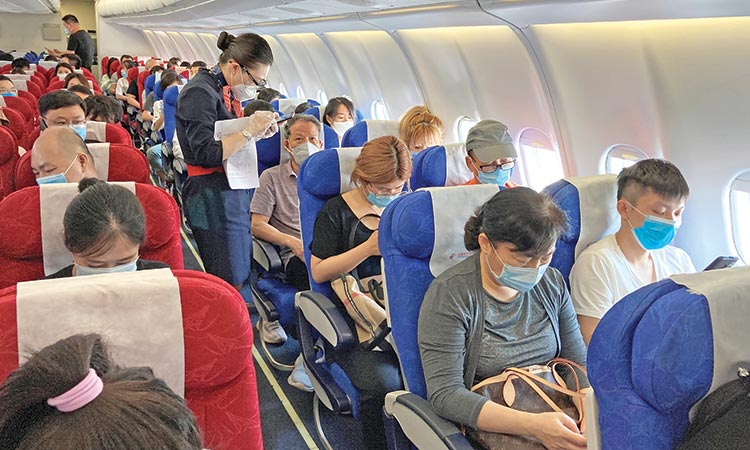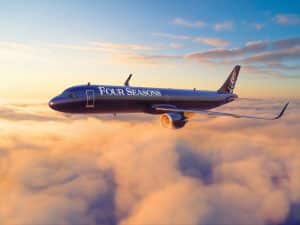
Global air passenger traffic plunged by an unprecedented 66 per cent in 2020 owing to travel restrictions imposed during the COVID-19 pandemic, an industry group said.
The International Air Transport Association (IATA) also warned that new, more transmissible variants of the coronavirus could hurt prospects for a recovery this year.
Given that travel restrictions have been applied mostly to international travel, domestic passenger traffic fared better, falling by 49 per cent, compared with 76 per cent for foreign passenger traffic.
Travel restrictions imposed during the first wave of the pandemic caused global passenger traffic to reach just five per cent of its normal level, with airlines parking planes on runways because no other space was available.
“Last year was a catastrophe. There is no other way to describe it,” an IATA statement quoted Director General Alexandre de Juniac as saying.
“What recovery there was over the Northern hemisphere summer season stalled in autumn and the situation turned dramatically worse over the year-end holiday season, as more severe travel restrictions were imposed in the face of new outbreaks and new strains of COVID-19.”
IATA chief economist Brian Pearce told a video news briefing: “Overall, global passengers kilometers flown were down two thirds, this is the biggest shock the industry of air travel has ever experienced.”
IATA, which represents 290 airlines, did not formally lower its outlook for a pickup in traffic this year thanks to a global rollout of vaccines, but warned that the emergence of new variants of the virus clouded the forecast.
And “we begin 2021, which we still expect to be a year of recovery, from a very low point,” Pearce noted.
The association officially expects traffic to increase by 50 per cent from last years levels, but that would still represent just half of the result seen in 2019.
And “the proliferation of restrictions on travel that we have seen since the beginning of the year could make even that modest outlook very challenging,” de Juniac told the press briefing.
“We are eager to work with governments as partners to understand what the benchmarks and conditions will be for a decision to give people back their freedom of movement,” he added.
One relative bright spot last year came from air freight, which declined by a relatively modest 10.6 per cent from the 2019 level as measured in cargo tonne-kilometers, or CTKs.
That was nonetheless the worst drop since IATA began using the measure in 1990.
As a result, global airlines suffered a combined loss of $370 billion last year, according to data compiled by the UN aviation agency ICAO.
Meanwhile, the COVID-19 pandemic heavily dented India’s aviation sector with its domestic air passenger traffic plunging by 55.6 per cent in 2020 on a year-on-year basis.
As per the data furnished by the International Air Transport Association on Wednesday, the fall in India’s domestic air passenger volume — measured in revenue passenger kilometres – was the third highest amongst major aviation markets such as Australia, Brazil, China, Japan, Russia and the US.
In the period under consideration, India’s domestic passenger traffic decline was preceded by that of Australia at 69.5 per cent and the US’s at 59.6 per cent.
The country’s domestic available passenger capacity – measured in available seat kilometres (ASKs) – fell by 48 per cent on a YoY basis.
India’s domestic air passenger volume plunged in March 2020 due to the imposition of a nationwide lockdown and the scare around the spread of COVID-19. It was on May 25 that gradual re-opening of the domestic operations was allowed.
At present, no foreign flights are allowed, however, operations under ‘air bubble’, evacuation and cargo are going on.
In terms of global passenger traffic demand, the data showed a fall of 65.9 per cent in 2020 from 2019 levels.
“International passenger demand in 2020 was 75.6 per cent below 2019 levels. Capacity declined 68.1 per cent and load factor fell 19.2 percentage points to 62.8 per cent,” IATA said.
“Domestic demand in 2020 was down 48.8 per cent compared to 2019. Capacity contracted by 35.7 per cent and load factor dropped 17 percentage points to 66.6 per cent.”
As per the data, bookings for future travel made in January 2021 were down 70 per cent compared to a year-ago, putting further pressure on airline cash positions and potentially impacting the timing of the expected recovery.
IATA’s baseline forecast for 2021 is for a 50.4 per cent improvement on 2020 demand that would bring the industry to 50.6 per cent of 2019 levels.
“While this view remains unchanged, there is a severe downside risk if more severe travel restrictions in response to new variants persist.”











